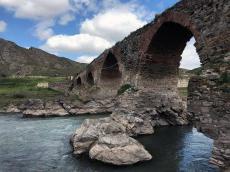Today.Az » Arts & Entertainment » Witnesses to history: Khudafarin bridges
22 September 2021 [15:35] - Today.Az

By Azernews
By Vugar Khalilov Historically, located on the major crossroads connecting the East and the West, Azerbaijan has been considered the melting pot for different cultures. Its geographical location and historical background have significantly shaped and enriched the country’s cultural heritage. Since antiquity, Azerbaijan has been a part of great empires and several states emerged on its territory. Therefore, the country is abundant with ancient monuments, historical sites, and ruins. The Khudafarin bridges, which were built in the Middle Ages over the Araz River at the Iranian border, are unique examples of Azerbaijan’s transit importance throughout history. The bridges have witnessed many historical events, including the valiant fights of the Azerbaijani army and its glorious victory in the Second Karabakh war, which also freed the historical monuments themselves from Armenia's long-lasting occupation. Historical background According to ancient Arab sources, several bridges were built throughout history over the Araz River to connect the settlements located on both sides of the river. The first information about the early bridges dates back to the eighth-ninth centuries when the Arab historians stressed their military and strategic importance for linking southern Azerbaijan (currently northwestern Iran) with the medieval cities of northern Azerbaijan (the Republic of Azerbaijan). The early bridges were usually built in the shallow parts of the river and often on the rocks. Nowadays, there are two survived Khudafarin bridges connecting the northern and southern banks of the Araz River in Azerbaijan’s liberated Jabrayil region. The 15-span bridge, which was built in the 12th century, is well preserved and still operational. The bridge was built on the Araz River in 1027 by Fazl ibn Muhammad, the Shaddadids emir of Arran, who ruled from 985 to 1031. It was one of the major crossing points of the historical Silk Road. The monument belongs to the Azerbaijani Arran architectural school. In the 18th century, the bridge was partially destroyed during the march to Azerbaijan by the founder of the Gajar dynasty of Iran, ruling from 1789 to 1797, Agha Mohammed Shah Gajar. It was later restored. Some parts of the bridge were built on natural rocks, which made it durable and survive to date. The second 11-span bridge, which was built in the 13th century, is mostly destroyed and only three middle spans have survived. Both of the bridges served as a major junction for the Great Silk Road and gained great international importance for being the major route for the movement of various forces and tribes, coming from the south to the region of Aran and Karabakh. The historical accounts underlined the military and strategic importance of the bridges, which enabled a large number of troops to cross the river in a very short time. The availability of large boulders in the riverbed made the location very advantageous for the bridge construction. Among the many bridges over Araz only Khudafarin bridges survived thanks to their favorable location. Architectural features The 15-span bridge was built on the boulders taking into account the landscape, which made the spans different in size. The bridge is about 200 meters long, 4.5 meters wide and the highest point reaching 10 meters above the water level. All the arches have a lancet shape typical for Islamic architecture. The archivolts were originally made from stone and the rest of the bridge was built of rough cobblestones. The parapet of the upper part of the entrance was made from brick. The combination of textures and colors of various building materials add clear tectonic structure and artistic peculiarity to the bridge. The second 11-span bridge is 750 meters away from the 15-span bridge and it entirely was built and lined with well-shaped blocks of limestone. Due to its three survived spans it is known as Siniq Korpu or broken bridge. The bridge is about 130 meters in length, 6 meters wide, and the height above water level is 12 meters. The surviving parts of the bridge convey a strong impression of its previous architectural features. Cultural importance Along with its sustainable engineering design, the Khudaferin bridges capture attention for their artistic aesthetic expression. As highly professional architectural and engineering facilities with amazing aesthetic nature, the bridges are considered monuments of universal significance. However, for many years there have been huge threats to the existence of these architectural gems. In 1990, Iran planned to build two water development facilities - Khudafarin and Giz Galasi (Maiden Tower) in line with the agreement made with the USSR in 1975. As a result of objections from Azerbaijan, Iran had to abandon the plan. Another threat was posed by Armenia's occupation of Jabrayil region in 1993 when the bridges were severely damaged. However, after a 28-year occupation, the Azerbaijani army liberated Jabrayil, where the bridges are located, and hoisted the Azerbaijani flag over them. The liberation of Jabrayil from the Armenian occupation on October 4, 2020, eliminated the existential threats and opened a new phase in the restoration of the monuments. In an interview with journalists, Azerbaijani Culture Minister Anar Karimov said that the Khudafarin bridges, along with Shusha city will soon be included in the UNESCO World Heritage List.
|